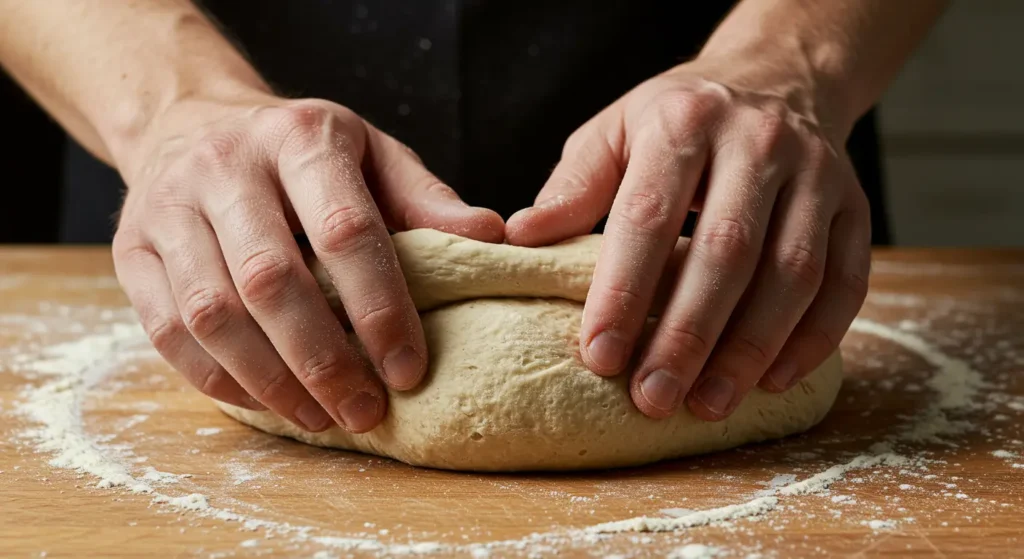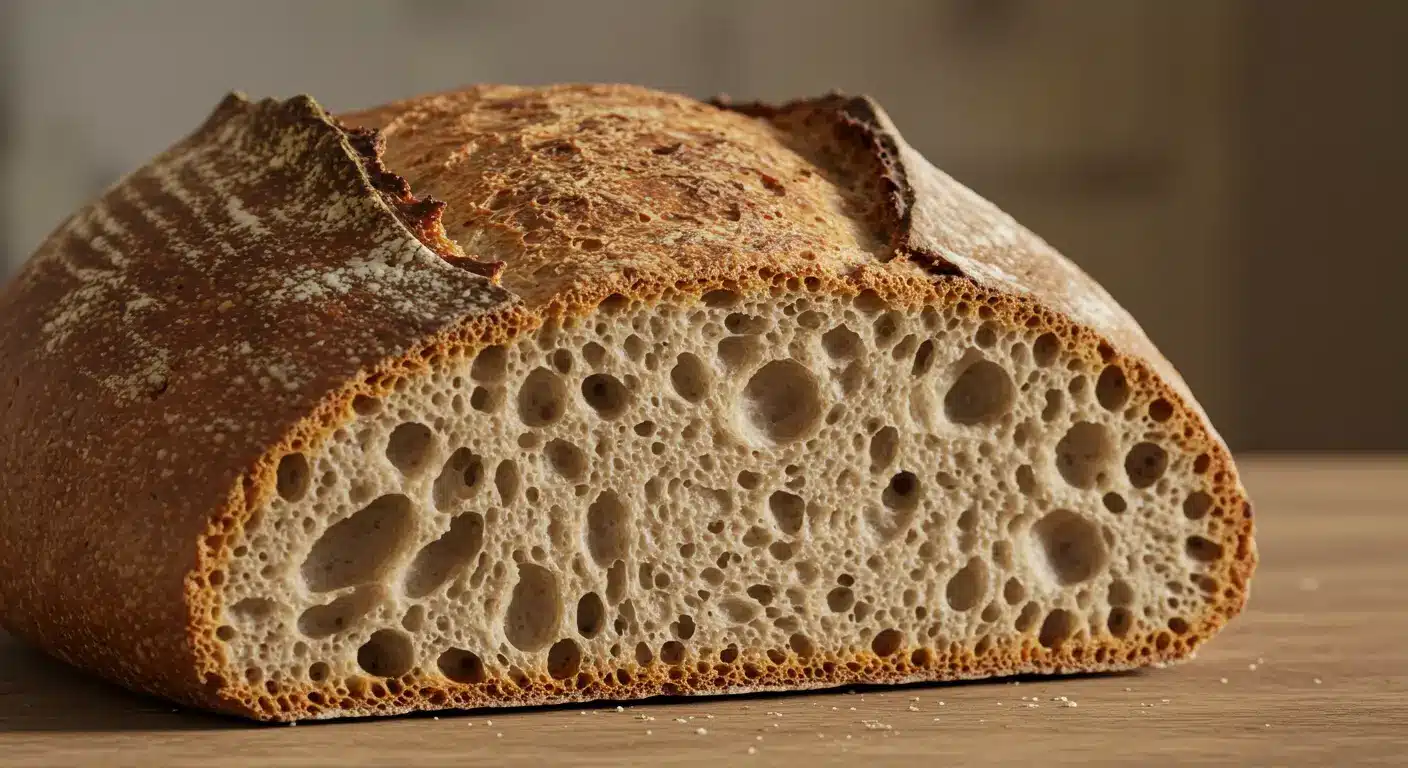Gluten Free Sourdough Bread – The Ultimate Guide for Healthier Baking
If you’re searching for bread that’s flavorful, gut-friendly, and gluten-free, you’re in the right place. This guide on gluten free sourdough bread explores everything from what it is, how it compares to regular sourdough, the best flours to use, and even how to make your own at home. Whether you’re new to gluten-free baking or a seasoned home baker looking for a new challenge, this article breaks it all down with clear steps and practical tips. You’ll also discover why this bread may be more than just a trend—it might be the healthier bread solution your gut and taste buds have been waiting for.
Learn more about gluten-free sourdough bread and how to bake it perfectly with our expert-approved guide.
Table of Contents
Understanding Gluten Free Sourdough Bread
What Is Gluten Free Sourdough Bread?
Gluten free sourdough bread is made without wheat, barley, or rye. Instead, it uses flours like brown rice, buckwheat, or sorghum. The dough is fermented with wild yeast and good bacteria, just like traditional sourdough, giving it a tangy flavor and soft texture.
What makes it special is the slow rise from natural fermentation. This makes the bread easier to digest and rich in nutrients. Unlike standard gluten-free loaves, sourdough skips additives and leans on natural processes for flavor and rise.
How It Differs from Traditional Sourdough
The big difference is the flour. Regular sourdough uses gluten-rich flour that gives it stretch. Gluten-free sourdough needs binding agents like psyllium husk or flaxseed to hold its shape.
It’s also a bit denser but still soft inside when done right. Traditional sourdough is known for its airy texture and chewy crumb, while the gluten-free version offers a denser, more hearty bite with a flavorful taste and a slightly crisp crust.
Why Choose Gluten Free Sourdough Bread
Health Benefits of Gluten-Free Fermented Bread
Choosing gluten free sourdough bread isn’t just about avoiding gluten—it’s also about what you gain. Natural fermentation makes this bread a great source of beneficial bacteria and prebiotics, which can help support a healthy gut. The fermentation process also helps break down phytic acid, improving the absorption of minerals like iron and magnesium.
Unlike most store-bought gluten-free breads, which rely on starches and fillers, sourdough is nutrient-dense and easier to digest. It may help reduce bloating, promote better digestion, and stabilize blood sugar levels after meals. That’s a win for anyone with gluten sensitivity or those seeking better nutrition from their bread.
Is Sourdough Anti-Inflammatory or Gut-Friendly?
Sourdough, especially when made with whole grain gluten-free flours, can support a healthy gut microbiome. The natural probiotics produced during fermentation may help calm inflammation in the body.
Some experts believe that the fermentation process reduces the glycemic index of bread, making it a smarter choice for those with autoimmune or inflammatory conditions. While not all sourdough is anti-inflammatory, gluten free sourdough bread made with high-fiber flours like millet or buckwheat can offer real gut benefits.
Looking for inspiration? Try our gluten-free cereal guide to explore nutrient-rich flour options for baking.
Key Ingredients in Gluten-Free Sourdough Bread

Best Gluten-Free Flours for Sourdough
The flour you choose is the foundation of your gluten free sourdough bread. Unlike wheat-based loaves, you’ll need to blend flours to get the right balance of flavor, structure, and nutrition. Top choices include brown rice flour, sorghum, buckwheat, teff, millet, and oat flour (certified gluten-free). These flours offer more than texture—they add fiber, protein, and minerals.
For best results, mix a base flour like rice or sorghum with a denser one like buckwheat or teff. Starchier options like tapioca or potato starch help create a lighter crumb. Avoid using just one flour alone—it won’t rise well or hold its shape.
Check out Pillsbury gluten-free flour if you’re looking for a convenient pre-mixed option for beginners.
Starters: How to Make a Gluten-Free Sourdough Starter
A gluten-free sourdough starter is essential for both the rise and the distinct tangy flavor of the bread. To create one, mix equal amounts of gluten-free flour and filtered water in a glass container. Stir the mixture once a day and continue feeding it with fresh flour and water daily for 5 to 7 days, until it becomes bubbly and develops a mildly sour aroma.
Brown rice flour is a common starter base because it ferments reliably. You can also use sorghum or buckwheat for a deeper flavor. Keep the starter in a warm, draft-free spot and always use clean utensils.
Once active, this starter becomes the heart of your gluten free sourdough bread. It’s what transforms simple ingredients into something wholesome and delicious.
Step-by-Step – How to Make Gluten-Free Sourdough Bread at Home
Ingredients and Tools You’ll Need
Making gluten free sourdough bread at home starts with the right setup. Here’s a basic list of what you need:
- Gluten-free flours (brown rice, sorghum, or a blend)
- Psyllium husk (to mimic gluten structure)
- Gluten-free sourdough starter (see Part 3)
- Filtered water
- Salt
- Mixing bowl, kitchen scale, silicone spatula
- Dutch oven or bread pan for baking
Optional but helpful: proofing basket, thermometer, and parchment paper.
Use a digital scale for precision. Gluten-free baking is less forgiving than wheat-based dough, and measuring by weight gives more consistent results.
Mixing, Proofing, and Baking Techniques

Start by mixing the starter, water, and flour in a bowl until combined. Let the mixture rest for 30 minutes so the psyllium can hydrate. Then, knead gently with a spatula or hands until it forms a smooth dough.
Transfer the dough to a loaf pan or banneton. Cover and let it proof at room temperature for 4 to 8 hours, or until it rises by about 50%. Don’t expect a dramatic rise—it’s slower and subtler than traditional dough.
Preheat your oven to 450°F. If using a Dutch oven, place it inside the oven to preheat as well. Score the top of the dough with a sharp knife or razor, then bake for 45–50 minutes. The crust should be firm and golden.
Let it cool completely before slicing. Gluten free sourdough bread finishes setting as it cools. Cutting it too early may lead to a gummy texture.
Don’t miss our gluten-free brioche bread for another delicious gluten-free baking option.
Tips to Improve Your Gluten-Free Sourdough Texture and Rise
Hydration Levels and Dough Handling Tips
Getting the texture right in gluten free sourdough bread depends a lot on hydration. Gluten-free flours absorb water differently, so your dough will look wetter than traditional wheat dough—but that’s a good thing. Aim for 90–100% hydration, which means nearly equal parts water and flour by weight.
If your dough feels too runny, let it rest longer to absorb the liquid. Don’t add too much flour, or you’ll end up with dense bread. Psyllium husk helps trap moisture and build a springy crumb, so don’t skip it.
Also, always mix gently. There’s no gluten to develop, so over-kneading isn’t necessary. Instead, focus on incorporating the ingredients thoroughly and allowing the dough to rest between steps.
Troubleshooting Common Gluten-Free Sourdough Issues
If your loaf comes out flat, it could be a sign that your sourdough starter isn’t active or strong enough to properly leaven the dough. Try feeding it for a few extra days and keep it in a warmer spot. A sluggish starter leads to poor rise.
Too gummy inside? That often means the loaf was underbaked or sliced too soon. Bake it longer at a slightly lower temp if needed and always let it cool before cutting. A bread knife and clean cut will keep the inside from compressing.
Dry or crumbly loaves usually need more hydration or better flour balance. Add starches like tapioca or potato for softness and adjust your mix with whole-grain flours to improve structure.
Want more ideas for flavor variations? Discover great ideas like sourdough apple fritter bread to explore new techniques and flavors.
Buying vs. Baking – Where to Find Gluten-Free Sourdough
Best Brands That Sell Gluten-Free Sourdough
If you’re not ready to bake or want convenience, you can absolutely buy gluten free sourdough bread. Several brands offer certified gluten-free loaves with great flavor and texture. Look for names like Simple Kneads, Bread Srsly, and New Grains Bakery. These companies often use traditional fermentation and safe, clean ingredients.
Online specialty stores and local health food shops are great places to start. Many bakeries also ship nationwide and even offer subscription boxes. Just be sure to double-check the ingredients and gluten-free certifications.
Buying saves time and can help you understand the flavor and texture to aim for in homemade versions. Plus, you can sample different flour blends before committing to baking your own.
How to Read Labels for Gluten-Free Verification
When shopping for gluten-free sourdough, don’t rely on packaging claims alone. Look for labels that say “Certified Gluten-Free,” which means the product was tested and meets FDA gluten limits.
Check the ingredients for any hidden gluten sources like malt or wheat starch. Phrases like “produced in a facility that processes wheat” may not mean the product contains gluten, but it’s a risk for those with celiac disease.
Also look for allergen statements and check the order of ingredients—high-quality sourdoughs should list a starter and whole-grain flours early on. The fewer additives and gums, the better.
Don’t miss our guide to bake gluten-free hamantaschen for more gluten-free product picks and tips.
Who Should Avoid or Be Cautious About Sourdough
Celiac Disease and Gluten Sensitivity Considerations
While gluten free sourdough bread is generally safe for gluten-sensitive individuals, not all sourdoughs are truly gluten-free. Traditional sourdough still contains gluten, even if fermented, and can trigger serious symptoms in people with celiac disease.
Even with gluten-free versions, cross-contamination is a real concern. If you’re baking at home, make sure all tools and surfaces are gluten-free certified. If you’re buying, only trust brands that are certified gluten-free and test below 20 ppm (parts per million) of gluten.
For those with non-celiac gluten sensitivity, gluten free sourdough is usually well tolerated, especially because of its natural fermentation. Still, every body reacts differently, so start with small amounts to test your response.
When Sourdough May Not Be the Best Choice
Even gluten-free sourdough bread might not suit everyone. Those with digestive conditions like SIBO (small intestinal bacterial overgrowth) or IBS may find the fermentation process triggers bloating or discomfort due to natural fermentation gases.
Also, some gluten-free sourdoughs are made with high-starch flours that can spike blood sugar levels. Diabetics or those managing insulin resistance should choose recipes made with whole grain flours like millet or teff.
If you’re following a grain-free or paleo diet, gluten free sourdough still won’t fit your lifestyle. In that case, look for almond or coconut flour-based recipes instead.
Don’t miss our look at gluten-free sourdough bread to decide if it’s right for your diet.
Gluten-Free Bread vs. Sourdough vs. Other Breads
Comparison of Ingredients, Taste, and Nutrition
Not all gluten-free breads are created equal. Basic gluten-free bread often uses starches and gums for structure but lacks fiber and nutrients. Gluten free sourdough bread, on the other hand, uses whole-grain flours and natural fermentation, which gives it a tangy flavor and better texture.
When compared to regular wheat sourdough, the gluten-free version is denser but still flavorful, especially when made with nutrient-rich flours like buckwheat or millet. It also avoids the common allergens in wheat, making it safer for people with sensitivities.
In terms of nutrition, gluten free sourdough often has more fiber and minerals than white sandwich bread or commercial gluten-free loaves. The long fermentation boosts digestibility and may help your body absorb nutrients better.
Which Bread Is Best for Reducing Inflammation?
If you’re looking to lower inflammation, gluten free sourdough bread is a smart choice—especially when made with anti-inflammatory flours like sorghum, teff, or oats. These ingredients are packed with antioxidants and fiber.
Traditional breads made with refined wheat can spike blood sugar and contribute to chronic inflammation. In contrast, gluten free sourdough’s slow fermentation and whole ingredients make it easier on the digestive system.
While no bread is a miracle cure, choosing gluten-free sourdough over processed white bread can be a step toward a more anti-inflammatory diet. For additional options, check out our gluten-free cereal guide to balance your meals with fiber-rich grains.
Recipes and Serving Ideas

Creative Gluten-Free Sourdough Bread Recipes
Once you’ve mastered the basics, you can get creative with your gluten free sourdough bread. Try adding seeds like chia, flax, or sunflower for extra crunch and nutrition. Herbs such as rosemary or thyme give your loaf an earthy flavor, while add-ins like olives or caramelized onions can transform a basic bread into a savory showstopper.
You can also experiment with flour blends to change the taste and texture. For example, a mix of brown rice, millet, and teff gives a mild, nutty profile with a soft crumb. For a slightly sweeter loaf, incorporate buckwheat or oat flour.
Looking to make it even easier? Use a pre-mixed gluten-free flour blend designed for sourdough baking. This can save time and reduce guesswork.
What to Serve With Your Gluten-Free Sourdough
This bread is extremely versatile. For breakfast, top slices with avocado, poached eggs, or almond butter and berries. It’s also great toasted with hummus or paired with soups and stews for lunch.
Use it as a base for gluten-free sandwiches or even French toast. It holds up well when sliced thin or thick, and its tangy flavor adds depth to any dish.
Need a unique serving idea? Don’t miss our bake gluten-free hamantaschen for a creative dessert pairing during holidays or brunch.
Conclusion
Gluten free sourdough bread isn’t just a substitute—it’s a game-changer for anyone who wants a flavorful, gut-friendly bread without gluten. Whether you’re baking at home or buying from trusted brands, it’s possible to enjoy real sourdough with all the tang and texture, minus the gluten.
From learning how to choose the best flours and creating a gluten-free sourdough starter, to troubleshooting rise and exploring health benefits, this guide covers everything you need to know. It’s time to reimagine gluten-free bread and enjoy the wholesome, rewarding simplicity of well-made sourdough.
Explore new flavor combinations, test easy recipes, and discover how fermented baking can support your wellness goals. Check out our guide to gluten-free sourdough bread for more insight, and don’t forget to bake gluten-free hamantaschen as your next project.
FAQs
Is any sourdough bread gluten-free?
No, not all sourdough bread is gluten-free. Traditional sourdough still uses wheat-based flour, which contains gluten. Only sourdough bread made with certified gluten-free flours and a gluten-free starter qualifies as gluten free sourdough bread. Always check labels or ingredients if you have celiac disease or gluten sensitivity.
What flour is best for gluten-free sourdough?
The best flours for gluten-free sourdough include brown rice flour, sorghum, millet, buckwheat, and teff. These flours offer structure, nutrition, and a great texture when used in combination. Most recipes use a blend to balance starch and protein for optimal rise and crumb in gluten free sourdough bread.
Can you buy sourdough gluten-free?
Yes, you can buy gluten-free sourdough bread from specialty bakeries and online shops. Brands like Bread Srsly and Simple Kneads offer certified gluten-free loaves that are fermented and flavorful. Just be sure to verify that the bread is certified gluten-free and made in a dedicated facility.
Is sourdough bread anti-inflammatory?
Sourdough bread—especially gluten-free versions made from whole grains—can support an anti-inflammatory diet. The fermentation process helps lower the glycemic impact and promotes gut health, which may reduce inflammation in some individuals. Choosing flours like buckwheat or teff in your gluten free sourdough bread adds even more anti-inflammatory benefits.
Who should avoid sourdough bread?
People with celiac disease should avoid regular sourdough bread unless it is specifically made gluten-free. Also, those with SIBO or other digestive sensitivities might react to fermented foods. Always consult a healthcare provider if you’re unsure how gluten free sourdough bread might affect your condition.
What is the best bread to eat to avoid inflammation?
Breads made with whole grains, high fiber, and no refined sugar or additives are best for reducing inflammation. Gluten free sourdough bread made with sorghum, millet, or buckwheat is a smart option. It’s naturally fermented, easy on digestion, and free from processed starches and fillers.

